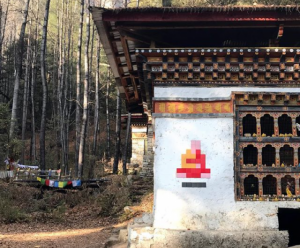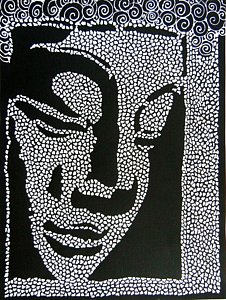
Acrylic on canvas. Image courtesy of the artist
Los Angeles-based Indian artist Kruti Shah creates imagery that celebrates the exquisite details and patterns of our natural world and the many powerful symbols that we employ to soothe and uplift our spirits. Using inks and acrylics, she builds up her grasshoppers, peacocks, lotus flowers, and Buddha figures using slender lines and tiny dots, capturing the essence of the original subject and infusing it with an exuberance that renders it almost magical. What is also noteworthy about much of her work is that it is infused with a spirituality that has its origins in her cultural roots. Although Shah does not describe herself as a Buddhist, she embraces many Buddhist ideas, practices meditation before she creates her art, and infuses her work with symbols and imagery from Indian philosophy and spirituality, suggesting that she is not simply interested in the beauty of the natural world, but its power to elevate our spirits.
Shah, who was born in the city of Vadodara (formerly Baroda), India, studied science, social work, and performing arts at the Maharaja Sayajirao University of Baroda, before pursuing a master’s degree in human resources in Chicago, where she moved in 1999. Now living in Temple City, just outside Los Angeles, she devotes her time to her artistic endeavors and has been showing her work widely in exhibitions and galleries around Southern California. A self-taught artist, Shah is extremely diverse in style, able to move easily from abstract paintings in acrylic on canvas, to photography, to detailed color drawings in gel ink on paper and bold monochrome silhouette portraits on collages of newspaper articles. Yet her works share a thoughtful quality—in the patterning and juxtaposition of colors—that draws the viewer’s eye deep into the work. In the polychrome drawing Beauty of the Spirit, Shah presents a bug’s eye view of a lotus in full bloom bursting with life and the promise of enlightenment. The tiny patches of color that she applies to fill in each area of her design are a key feature of her representations of flowers, insects, and birds. Like a Pointillist painter, she builds up the image using repeated applications or dots of color, creating a final image that appears almost pixelated, and softer than if color filled each cell entirely.
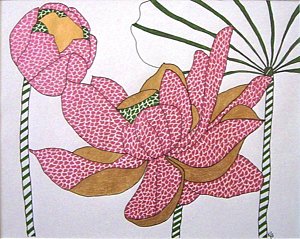
Gel ink on paper. Image courtesy of the artist
Such detailing is more than an artistic device for Shah. “The process of creation is meditative,” she reveals. “It transcends me to another world; the state of absorption emphasizing insights into the Bodhisattva ideal, into Buddha’s nature.” Before she begins to paint, Shah meditates. Then she picks up her tools—typically acrylics, metallic inks, paper, or canvas—and begins a process that that is not so much creating, but rather a means to allow her subject to emerge amid the lines and patterns. “One line brings the next line, until something grows and takes its shape. As if the colors have a mind of their own, they either blend into each other or dissect the painting into dimensions giving each creation its own identity and character.”

Gel ink on canvas. Image courtesy of the artist
For her abstract patterning too, Shah enters a meditative state as she repeatedly applies dots of distinct colors to build up her patterns into a complete image. Her series “Entropical Evolution” is a collection of geometric patterns inspired by the work of Spanish artist Antonio Gaudi. Just as she has done to create the image, she invites viewers to enter the image and begin their own contemplative journey. Although she uses very different techniques in her abstract paintings, Shah evokes a similar meditative effect in these bold images. Her painting Galaxy, for example, works as a multi-layered, polychrome Zen circle that at once arouses and focuses the spirit. In such works, Shah “invites the viewer to experience love, peace, serenity, joy, and beauty in that moment”—the goal of many works of Zen Buddhist art.
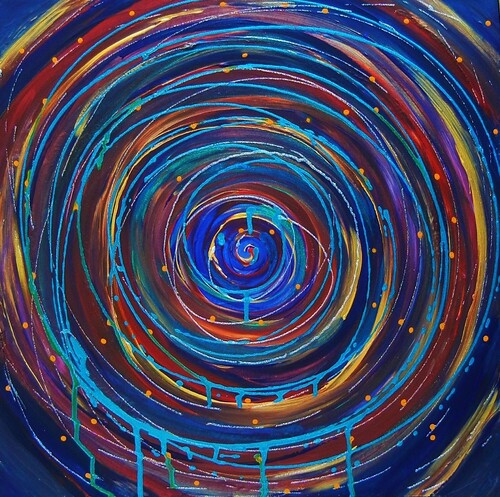
Acrylic on canvas. Image courtesy of the artist
Spiritual focus is clearly the aim of her series titled “Zen N Art,” a collection of faces of the Buddha drawn from Thai and Gandharan statuary that have been highlighted with gold accents, delicately detailed spiraling on the hair, and occasional rows of Buddhist mantras, such as in the work Buddham Saranam Gacchami. Highly contemporary and graphic in their conception, these works exhibit a simplicity and a calm that would allow them to serve as visualization and meditational aids for a practitioner. Similarly, her collection of Hindu and Buddhist mantras also serve as focal points for visualization and contemplative practice.

Ink and gold pigment on paper. Image courtesy of the artist
Though calming—soothing imagery features widely in her work—she also uses familiar Buddhist imagery to provoke thoughts and inspire action. Her bold mixed-media work Peace Please depicts an iconic silhouette of the Buddha’s head painted onto a collage of newspaper articles describing warfare, political battles over healthcare, and police violence. Reminiscent of street-art stenciling, this powerful image reminds the viewer of the ongoing need for peace and calm amid the constant social and political turmoil that surrounds us daily. By painting the head of the Buddha over the news articles, Shah is perhaps suggesting that we need to alter our daily priorities if we hope to achieve peace.
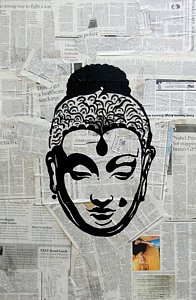
Mixed media. Image courtesy of the artist
In all her artistic explorations, Shah shares her own personal spiritual journey, using familiar representations of nature and Buddhist imagery in new, contemporary approaches. “For me it is passion unleashed,” she explains. “I hope to create a spark of connection with the world around me.” Indeed, her passion for color, her playful approach to line, and the many references to her Indian cultural and spiritual heritage make her work unique and very accessible in its cheerful, enthusiastic approach to art, spirituality, and life.
See more
Related features from Buddhistdoor Global
Stepping into the Mandala – A Journey to Ankor Wat
Seamless Stitches: From Emptiness, Springs Form – Helene Rein’s Crafted Works
Don Farber’s Portraits of Buddhist Life




